Embracing Pretend Play: 5 Tips for Parents Who Don’t Like to Play
I’m an early childhood teacher. I’m a mother to a three year old. And I. don’t. like. to. pretend.
This is a big confession and has been a huge struggle for me, especially as a parent. I can pretend at school – I can put on a good show while telling and reading stories to the class, and throw a little theatre into any learning situation with my 5 – 8 year old students. It’s the toddler and preschooler play that I particularly struggle with. Pebble, our daughter, has just turned three and she loves absolutely nothing more than pretending. This parenting challenge has reached its peak.
I know how important pretend play is. It is one of the most invaluable learning experiences that a child can have. Through pretend play children develop language and problem solving skills. They build social skills and learn how to create stories. The make sense of the world around them by playing out situations from their own lives. In the past week alone the pretend play in our house has included these real life themes:
- birth and families – a new sibling for her is arriving any day now
- death – why can’t she see Daddy’s Daddy?
- child care routines – Pebble goes to child care twice a week
- sleepovers – she had a sleepover at her Grandma’s house recently
- rules and consequences – every day issues!
It’s about time that I faced this parenting challenge head on and learned to embrace pretend play. Today I’m sharing advice for you and for me on how to enjoy pretend play with your little ones.
1. Learn How Kids Tick
Toddlers and preschoolers are learning so much about how to be in their world. They are still learning how to take turns, share and express themselves. Toddlers and preschoolers are still easily frustrated and can be impatient. Help them to figure it out by modelling sharing and turn taking, praising their efforts to do the same and finding a diversion when frustration hits. Also know when to hit ‘pause’ on the play and have a milk break.
2. Suck It Up
Children enjoy playing the same scenes over and over and over again. One afternoon we played “I’m the witch, and you’re the girl, and you get locked in the tower, and the fairy sets you free” about 99 million times. It’s going to happen. Accept it. And refer to number five if needed!
3. Try New Ideas
So you’re sick of playing witches? To try and escape playing victim to that witch quite so often, set up new play scenes. Try setting up a post office, a cupcake shop, a city or a school. Real life experiences capture children’s interests most, as they are able to connect with the theme more easily. Or try looking to your children’s favourite books and stories for inspiration.
4. Use Household Props
Look around your home for props in unexpected places. You don’t need expensive play sets – have a tea party with the Tupperware, use a pile of cushions to create a mountain, make a boat out of a washing basket or create a house under the dining room table. This morning our couch and a pile of cushions became a rocket bound for the sky! You are limited only by your imaginations.
5. Take a Break
Sometimes you’re going to get fed up of pretending to be the doggy and your little one will still want to play. Before everyone gets too frustrated try taking a break from the play altogether. Have a few activities in the back of your mind that you know will divert your child’s attention long enough for you to get the brain break you need – head out for a swing, make a snack together, check the letter box (one of Pebble’s favourites), play with blocks… whatever may take your child’s fancy. You can come back to the play later feeling a little more refreshed and ready to enjoy.
What’s your favourite way to play with your children? What type of play do you try to avoid?
Editor’s note: Sending congratulations to Kylie and her family as they celebrate the birth yesterday of a beautiful, healthy baby boy! Pop over to the Octavia and Vicky Facebook page for a peek and to say hi 🙂
Related Posts
- Can Toddlers Play Independently?
- Managing Play with Children of Different Ages
- Encouraging Independent Play
- Visit the Childhood 101 Imaginative Play board on Pinterest

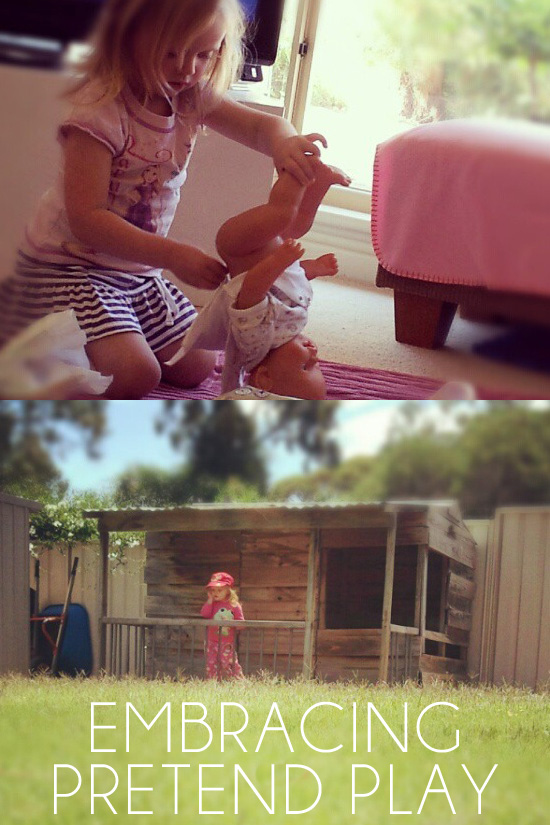
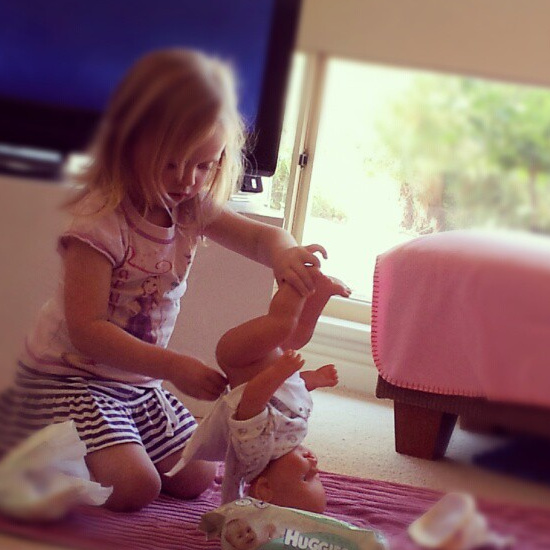
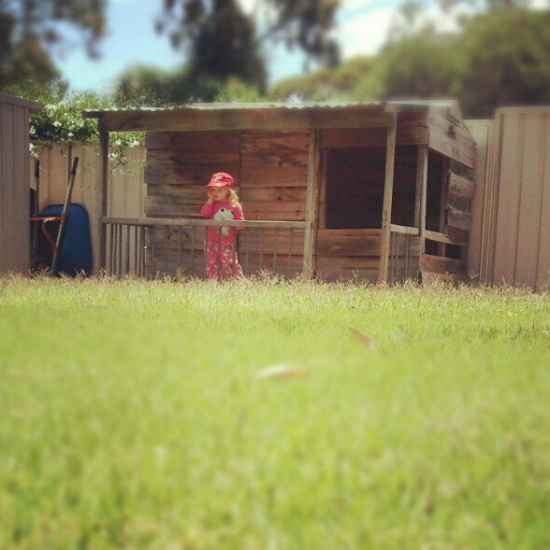
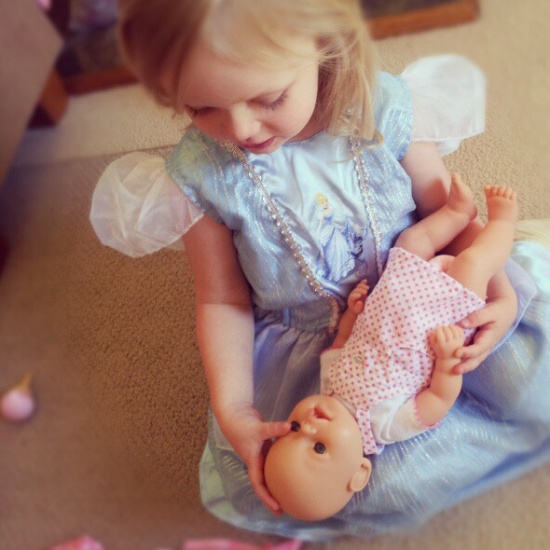
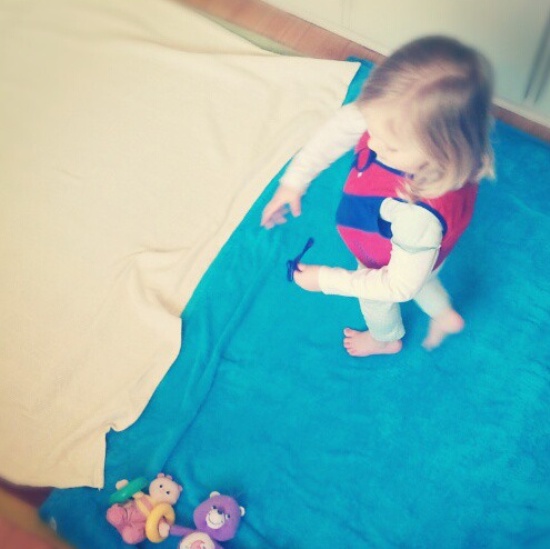
Okay, confession time. I totally loved the toddler/preschool play. Well, not all the time. I remember watching in utter amazement as my brother’s friend sat on the couch for what seemed like FOREVER (AKA about 20 times longer than the game would have kept my interest) playing pretend with my daughter and her Care Bears. At this age, I was way better at “The Why Game” then playing pretend.
Fast forward to now. My daughter is nearly 9 and has never outgrown this type of play. Now, it’s with toy horses. Every. Single. Day. Usually, she entertains herself with this pretend play, but every once in a while she begs me to join her. I am still horrible at playing pretend with her. I’d much rather read with her, bake with her, help her perform science experiments, or go on a mini backyard adventure with her. Pretend play still isn’t my thing.
So, I don’t play. But I do encourage her to delve deeper into creating a story. I gave her my video camera to make her own little films, and I recently began photographing her toy horses after she’s gone to school. They’re always left set up in such elaborate scenes, and I’ve found focusing on the little details has helped me understand a little better at how the game works in her mind. And that is how pretend play goes down in our house. It might not be perfect, but we make it work.
What a great post! I, too, struggle with playing “pretend” for more than 10 minutes at a time. I love playing “restaurant” or “store” or “mommy”. It’s when I have to make Barbie have a conversation with other-Barbie that goes like this:
“Hi Barbie, how are you?”
“I’m good. I’m going for a drive in my car.”
“That sounds like fun; may I come?”
“No! You can’t! I’m a dinosaur-Barbie. I’m going to eat you now! *shrieking laughter, rolling around*”
Okay. Seriously?
I do need to make a better effort to get in the action, though. This post helped to reinspire me. I’m not going to invite the Barbies, though.
I’m excited to pretend play, or a higher-level version of it. Right now, my 2.5yo engages in play scenarios with his cars where they have trouble taking turns. It’s not a long scene, but quite repetitive. And that’s getting to the part I don’t enjoy: playing the same thing on repeat. Argh. I know it’s important, but but but. I’ll be taking loads of breaks.
Kyle I’m with you. I love to paint, explore outdoor, hike, playdough, music and singing, baking/cooking, love love to read together, etc. I just can’t seem to muster up the pretend play. I feel guilty even. I just tell myself that’s what her friends are for and To remember that We all have our qualities/strengths and this will teach her that we don’t have to be everything/perfect.
I try to be honest with my 6 yro daughter(only child) about my short comings 🙂
Hi Kylie
I really appreciate your honesty and your ideas are great too. I have noticed my daughter engaging in a lot of pretend play by herself. She talks to herself, her dolls etc and doesn’t think anyone is listening. She might often say “help me Mum” and just as I am about to go to her aid, I realise she is just talking to one of her toys and perhaps she’s the mum!
Hi Kylie
I loved this post and can very much relate. My daughter is awesome at playing on her own & I encourage that, but sometimes I become a prop similar to your princess – ie someone she can boss around & feel like she’s in charge :-). I was actually looking for some good posts on make believe play as resources for my new ebook – 15 Minute Power Plays With Your Kids: How To Be A Better Parent in 15 Minutes A Day – where I have 31 suggestions of quality time activities with your kids that can be done in short windows of time. I have 2 “make believe” ones – a general Make Believe one and another inspired by my daughter – Let Your Child Pretend to ‘cook’ you dinner (I got to lay back on the couch while she presented me with my ‘food’ which wasn’t the most stressful ‘playing’ I’d ever had to do!!).
I’d love to link to this blog in my Resources section if you’re ok with that. I always like to ask permission if I can – just etiquette really. I’ll try to email you too.
Many thanks, & I must say your blog was not only informative, but also gave me a good chuckle.
Cheers
Louise Bibby
15minutepowerplayswithyourkids.com (in construction!)